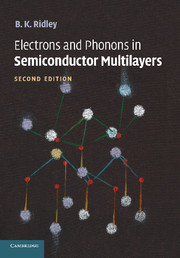Book contents
- Frontmatter
- Contents
- Preface
- Introduction
- 1 Simple Models of the Electron–Phonon Interaction
- 2 Quantum Confinement of Carriers
- 3 Quasi-Continuum Theory of Lattice Vibrations
- 4 Bulk Vibrational Modes in an Isotropic Continuum
- 5 Optical Modes in a Quantum Well
- 6 Superlattice Modes
- 7 Optical Modes in Various Structures
- 8 Electron–Optical Phonon Interaction in a Quantum Well
- 9 Other Scattering Mechanisms
- 10 Quantum Screening
- 11 The Electron Distribution Function
- 12 Spin Relaxation
- 13 Electrons and Phonons in the Wurtzite Lattice
- 14 Nitride Heterostructures
- 15 Terahertz Sources
- Appendix 1 The Polar-Optical Momentum-Relaxation Time in a 2D Degenerate Gas
- Appendix 2 Electron/Polar Optical Phonon Scattering Rates in a Spherical Cosine Band
- References
- Index
8 - Electron–Optical Phonon Interaction in a Quantum Well
Published online by Cambridge University Press: 05 September 2009
- Frontmatter
- Contents
- Preface
- Introduction
- 1 Simple Models of the Electron–Phonon Interaction
- 2 Quantum Confinement of Carriers
- 3 Quasi-Continuum Theory of Lattice Vibrations
- 4 Bulk Vibrational Modes in an Isotropic Continuum
- 5 Optical Modes in a Quantum Well
- 6 Superlattice Modes
- 7 Optical Modes in Various Structures
- 8 Electron–Optical Phonon Interaction in a Quantum Well
- 9 Other Scattering Mechanisms
- 10 Quantum Screening
- 11 The Electron Distribution Function
- 12 Spin Relaxation
- 13 Electrons and Phonons in the Wurtzite Lattice
- 14 Nitride Heterostructures
- 15 Terahertz Sources
- Appendix 1 The Polar-Optical Momentum-Relaxation Time in a 2D Degenerate Gas
- Appendix 2 Electron/Polar Optical Phonon Scattering Rates in a Spherical Cosine Band
- References
- Index
Summary
There's some that swear by whisky,
There's some that swear by rye,
There's some that swear by A.p,
And others by eø.
On Seeing the Light, B. K. RidleyIntroduction
An electron in a quantum-well subband can be scattered to another state in the same subband or into a state in another subband. Intrasubband and intersubband scattering rates have to be calculated separately since different wavefunction symmetries are involved in the two cases, and this implies correspondingly different symmetries of the optical mode. For simplicity we will assume that the electrons are completely confined within the well and that the interaction is with polar-optical modes. In the case of LO modes in a polar material this interaction is via a scalar potential. However, as we will see, it is possible in the unretarded limit (velocity of light is infinite) to replace the vector potential of the electromagnetic interface wave with a scalar potential via a unitary transformation (not a gauge transformation) and treat the IP mode on the same footing as an LO mode, but with a frequency-dependent scalar potential. We assume the TO mode has no interaction.
No fewer than four different scattering sources exist, in general. Two of these are associated with well modes, two with barrier modes. In general, the LO band of frequencies in either material does not span the range between the LO and TO zone-centre frequencies ωLO and ωTO.
- Type
- Chapter
- Information
- Electrons and Phonons in Semiconductor Multilayers , pp. 182 - 216Publisher: Cambridge University PressPrint publication year: 2009

